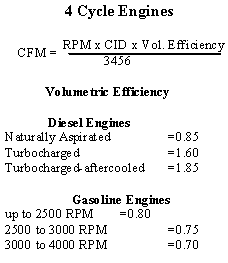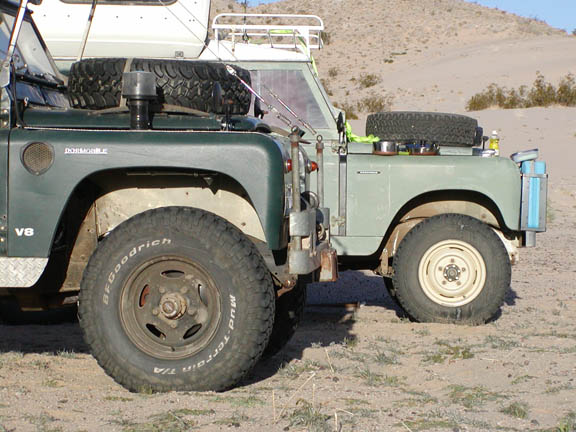I suggest that folks with after market carbs who haven't already done so find a place where they will stick an O2 sensor up your tail pipe and just give you an air to fuel ratio number. Knowing what it is allows you to dial in a main jet for best fuel mileage. These carbs often are jetted wrong for the Land Rover engine.
There are a lot of things that affect fuel mileage on a LR. Such as weight, tyre type, top or no top, altitude, where you drive and how your right foot treats the pedal. Most hard top LRs with the right air fuel mixture seem to get around 15-16 US MPG on the open highway and 7-9 MPG stop and go driving. If you plug the 2.25L's numbers into an engine volumetric efficiency formula you will get a flow rate of 128.6621 CFM at 4250 RPM, the max. rated power for the 2.25 engine.
Here are some numbers from the formula:
engine RPM - CFM
2000 - 64.6
2500 - 80.7 (peak torque)
3000 - 96.7
3500 - 105.9
4000 - 121.1
4250 - 128.7 (peak HP)
Tests performed by Jim Allan showed that the oil bath filter with its 90 degree adapter becomes more restrictive with increased air demand and "pretty much falls on its face by 3800 RPM" Its great for getting the particles out of the air going into your engine and suitable for regular driving below about 3500 RPM. On the other hand a K&N will breath freely through the engine's RPM range but does a lousy job of cleaning the air. OK for highway use but maybe not the best choice off the pavement. Some people carry both and switch between them depending upon where they drive.
A quick note about air flow & the smaller venturi carbs: a carb with a smaller venturi will normally produce more torque at a lower/mid rpm range because the velocity of the air/fuel mixture through the venturi will be higher and you get better fuel atomization and better combustion. Air flow testing referenced below was done by Jim Allen close to sea level. With that in mind:
The Solex flows 115CFM @ 1.5" of mercury. Traditionally the Solex is an excellent carb for trail driving and works very well at lower RPMs. But it is more restrictive than the other carbs at freeway speeds.
The factory Zenith flows 127CFM @ 1.5" mercury. Traditionally the Zenith is a good performer across the RPM range and a smooth running carb. It is usually considered the best choice for a 7:1 engine and a good choice for a stock 8:1 engine. It is a little flat at peak HP RPMs but few people ever drive there.
Rochester B carbs comes in different venturi sizes. You want the one that came on the smallest Chevy inline six. It flows 167CFM @ 1.5" mercury which is enough to handle the entire RPM range of a 2.25L engine. It is a very simple carb with a centre float that works well at high off road angles. The main jet is at the top of the fuel bowl so a little crud in the bottom of the bowl doesn't affect it.
Weber 34-ICH carbs usually sold for use with LRs are a generic replacement carb. They often come jetted too lean for the LR engine. When they do people report really good fuel mileage but tend to burn a valve or piston from running too lean. If you are getting better than 16 MPG highway on one have your air to fuel ratio checked to make sure it is jetted correctly. Different versions of this carb can have different flow ratings. One commonly found on LR engines flows 138CFM @ 1.5" of mercury. The Webers can often develop problems from crud getting past the fuel filter. Its main jet is at the bottom of the float chamber where it is easily clogged by particulate matter. So a good fuel filter, replaced often is essential for keeping these carbs trouble free.
The 2.5L engine came from the factory with a 32/34-DMTL progressive 2 barrel Weber. Unfortunately this is a discontinued carb & is hard to find in the US. Venturi sizes are 26/27 mm. This carb flows 194CFM @ 1.5" of mercury. This carb was coupled with an additional quarter liter displacement and the 2.5L cam with 8:1 head. It is usually considered a good choice for a performance rebuilt 2.25 engine. But the carb is hard to come by unless you buy a complete 2.5 engine.
The 38-DGAS 36/36 Weber commonly sold in the US for use on a LR is flow rated at 424CFM @ 1.5" of mercury and is way too much carb for the engine. Its venturi size is 36/36mm.
Another 2 barrel carb often sold in the US for LRs is the Weber 28/36-DCD. Its venturis are 26/27 MM. Its flow rate is 224CFM @ 1.5" of mercury. This is still way more than a 2.25L can handle, but some people have been able to jet it down well enough that it works on a LR engine.
My thoughts are that for a stock engine staying with the stock carb is always a good choice as long as it is running within spec. If you feel a need for an aftermarket carb, the Rochester B series that came on the small Chevy six and the generic replacement Weber 34-ICH are both good choices so long as they are jetted properly. The Rochester often comes over jetted and the Weber often comes under jetted. You really want to have the air fuel ratio tested to get the jetting right.
There are a lot of things that affect fuel mileage on a LR. Such as weight, tyre type, top or no top, altitude, where you drive and how your right foot treats the pedal. Most hard top LRs with the right air fuel mixture seem to get around 15-16 US MPG on the open highway and 7-9 MPG stop and go driving. If you plug the 2.25L's numbers into an engine volumetric efficiency formula you will get a flow rate of 128.6621 CFM at 4250 RPM, the max. rated power for the 2.25 engine.
Here are some numbers from the formula:
engine RPM - CFM
2000 - 64.6
2500 - 80.7 (peak torque)
3000 - 96.7
3500 - 105.9
4000 - 121.1
4250 - 128.7 (peak HP)
Tests performed by Jim Allan showed that the oil bath filter with its 90 degree adapter becomes more restrictive with increased air demand and "pretty much falls on its face by 3800 RPM" Its great for getting the particles out of the air going into your engine and suitable for regular driving below about 3500 RPM. On the other hand a K&N will breath freely through the engine's RPM range but does a lousy job of cleaning the air. OK for highway use but maybe not the best choice off the pavement. Some people carry both and switch between them depending upon where they drive.
A quick note about air flow & the smaller venturi carbs: a carb with a smaller venturi will normally produce more torque at a lower/mid rpm range because the velocity of the air/fuel mixture through the venturi will be higher and you get better fuel atomization and better combustion. Air flow testing referenced below was done by Jim Allen close to sea level. With that in mind:
The Solex flows 115CFM @ 1.5" of mercury. Traditionally the Solex is an excellent carb for trail driving and works very well at lower RPMs. But it is more restrictive than the other carbs at freeway speeds.
The factory Zenith flows 127CFM @ 1.5" mercury. Traditionally the Zenith is a good performer across the RPM range and a smooth running carb. It is usually considered the best choice for a 7:1 engine and a good choice for a stock 8:1 engine. It is a little flat at peak HP RPMs but few people ever drive there.
Rochester B carbs comes in different venturi sizes. You want the one that came on the smallest Chevy inline six. It flows 167CFM @ 1.5" mercury which is enough to handle the entire RPM range of a 2.25L engine. It is a very simple carb with a centre float that works well at high off road angles. The main jet is at the top of the fuel bowl so a little crud in the bottom of the bowl doesn't affect it.
Weber 34-ICH carbs usually sold for use with LRs are a generic replacement carb. They often come jetted too lean for the LR engine. When they do people report really good fuel mileage but tend to burn a valve or piston from running too lean. If you are getting better than 16 MPG highway on one have your air to fuel ratio checked to make sure it is jetted correctly. Different versions of this carb can have different flow ratings. One commonly found on LR engines flows 138CFM @ 1.5" of mercury. The Webers can often develop problems from crud getting past the fuel filter. Its main jet is at the bottom of the float chamber where it is easily clogged by particulate matter. So a good fuel filter, replaced often is essential for keeping these carbs trouble free.
The 2.5L engine came from the factory with a 32/34-DMTL progressive 2 barrel Weber. Unfortunately this is a discontinued carb & is hard to find in the US. Venturi sizes are 26/27 mm. This carb flows 194CFM @ 1.5" of mercury. This carb was coupled with an additional quarter liter displacement and the 2.5L cam with 8:1 head. It is usually considered a good choice for a performance rebuilt 2.25 engine. But the carb is hard to come by unless you buy a complete 2.5 engine.
The 38-DGAS 36/36 Weber commonly sold in the US for use on a LR is flow rated at 424CFM @ 1.5" of mercury and is way too much carb for the engine. Its venturi size is 36/36mm.
Another 2 barrel carb often sold in the US for LRs is the Weber 28/36-DCD. Its venturis are 26/27 MM. Its flow rate is 224CFM @ 1.5" of mercury. This is still way more than a 2.25L can handle, but some people have been able to jet it down well enough that it works on a LR engine.
My thoughts are that for a stock engine staying with the stock carb is always a good choice as long as it is running within spec. If you feel a need for an aftermarket carb, the Rochester B series that came on the small Chevy six and the generic replacement Weber 34-ICH are both good choices so long as they are jetted properly. The Rochester often comes over jetted and the Weber often comes under jetted. You really want to have the air fuel ratio tested to get the jetting right.


 . My current K&N is too small and actually restricts airflow on the interstate. But I noticed the big K&Ns at Advance auto are only $35 so I'll be switching over to one of those here directly.
. My current K&N is too small and actually restricts airflow on the interstate. But I noticed the big K&Ns at Advance auto are only $35 so I'll be switching over to one of those here directly.





Comment